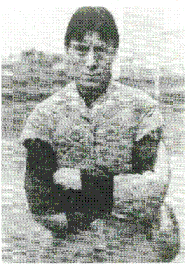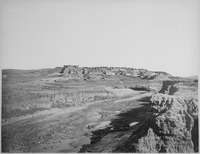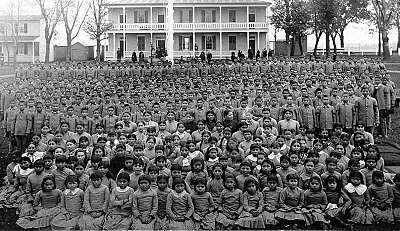Frank Hudson (American football)
Frank Hudson (1875 – December 24, 1950) was a Native American football player and coach. He was a member of the Laguna Pueblo tribe from New Mexico.
Frank Hudson | |
|---|---|
 Photograph of Hudson from the American Indian Athletic Hall of Fame | |
| Born | 1875 |
| Died | December 24, 1950 (aged 74–75) |
| Citizenship | United States |
| Alma mater | Carlisle Indian Industrial School |
He played college football for the Carlisle Indian Industrial School from 1895 to 1899 and was considered the greatest kicker in the early years of American football. In 1898, he became the first Native American player of the sport to be selected as an All-American. He was selected as a first-team All-American by Outing magazine in both 1898 and 1899.
From 1904 to 1906, he served as an assistant coach of the Carlisle football team, becoming one of the first non-white coaches in college football history.
Early years

Hudson was born around 1875 in Paguate, New Mexico. His date of birth was unknown.[1] He was a member of the Laguna Pueblo tribe.[2]
Carlisle
Football player

Hudson left his home and tribe in New Mexico to attend the Carlisle Indian Industrial School, an Indian boarding school in Carlisle, Pennsylvania, formed for the purpose of assimilating Native American children from 39 tribes into the majority culture. While at Carlisle, Hudson became a star on the school's football team.[3] He was the quarterback at Carlisle as early as 1895.[4][5] In December 1896, he played in what is reported to have been "the first game under electric light"—a victory over Wisconsin.[2] According to a press account from 1897, Hudson was only five feet, three inches tall, and weighed 130 pounds.[6]
1897 season
In 1897, Hudson gained acclaim for drop-kicking field goals against two of the top teams in the country—Yale and Penn.[2] Hudson accounted for all of Carlisle's points in a 20-10 loss to Penn at Franklin Field in Philadelphia. The New York Times wrote that "little Hudson showed his ability as a kicker by dropping the ball squarely between the posts."[7] The game against Yale was played at the Polo Grounds in New York, and The New York Times described Hudson's field goal as follows:
"[S]teadying himself for an instant the ball was dropped and with a delicate touch from his foot was sent sailing straight as a die toward the Yale goal. The spectators held their breath and watched the ball as it sailed on just over the heads of the Yale players and finally dropped over the bar. Then they cheered and young Hudson was the hero of the day. The goal was one of the prettiest ever seen ..."[8]
The success of the Carlisle football team was a source of great pride for Native Americans. In 1897, the Indian Helper (the Carlisle school newspaper) described a celebration that greeted the football team on its return from a game played in New York City against Yale University:
"On Monday morning after breakfast, the football team, who returned the evening before from the Yale game which was played at New York last Saturday, was treated to a free ride across the parade, in the large four horse herdic, drawn by the entire battalion. Capt. Pierce, Frank Cayou, Frank Hudson, and Martin Wheelock occupied the small phaeton drawn by boys, and went in advance of the others. The band played lively marches, as handkerchiefs waved and mouths shouted. The demonstration was a great surprise to all making a unique scene for such an early morning hour. The school is proud of the record made for clean playing, and were gratified that the boys scored.”[9]
1898 season
In 1898, Hudson became the captain of the Carlisle football team. In October 1898, he accounted for all five of Carlisle's points in an 18-5 loss to Yale. The New York Times reported: "The five points to Carlisle's credit are due to Quarterback Hudson's marvelous skill in kicking a goal from the forty-five-yard line. The trick caused consternation in the Yale line."[10] The following week, Hudson again accounted for all of Carlisle's points in an 11-5 loss to Harvard.[11] At the conclusion of the 1898 season, he was selected as the first-team quarterback on Outing magazine's 1898 College Football All-America Team.[12] He was the first Native American player to be selected as an All-American.[13]
1899 season
Hudson was the quarterback and drop-kicker for the 1899 Carlisle Indian team that compiled a 9-2 record. In a 22-10 loss to Harvard, Hudson's kicking was again a featured attraction. The New York Times reported: "And now came the feature of the game, for which everybody had been waiting. The Indians advanced the ball to Harvard's thirty-five-yard line, when Hudson dropped back for a goal from the field. A second later and the pigskin went straight through the goal posts, and everybody was digging his neighbors' ribs and saying, 'I told you so.'"[14] For the first time, Carlisle defeated one of the "Big Four" of college football, defeating Penn by a score of 16 to 5.
The 1899 Carlisle team drew further acclaim after defeating Columbia, 45-0, in a Thanksgiving Day game played at Manhattan Field near the Polo Grounds in New York. Hudson drop-kicked four goals from touchdown and one field goal in the victory over Columbia. The New York Times cited Hudson's use of the drop kick technique as one of the features of the game:
"The other novelty was the way in which Hudson kicked goals. Instead of making a kick from a placed ball held by one of his eleven he chose to make all his tries for a goal by a drop kick, and he succeeded in most of his efforts. It was a new feature for a match game, though frequently tried in practice."[15]
With its only two losses having come to Harvard and Princeton (ranked No. 1 and No. 2 in the country), the 1899 Carlisle team was ranked No. 4 in the country by Walter Camp.[16]
For the second consecutive year, he was selected as a first-team All-American on Outing magazine's 1899 College Football All-America Team.[17] He was also selected as a third-team All-American on Walter Camp's 1899 All-America team.[16]
The 1899 Carlisle team concluded its season with a 2-0 victory over an undefeated University of California team on Christmas Day in San Francisco. On the return trip from California, the Carlisle team stopped at the Haskell Indian Institute in Lawrence, Kansas, where a 12-year-old Jim Thorpe was in the crowd that greeted Hudson, Isaac Seneca, Martin Wheelock, and the rest of the Carlisle team.[16]
Legacy
For years after his playing career ended, Hudson was considered to have been the greatest kicker in the sport's history.[18][19][20] In 1910, one sportswriter noted:
"Frank Hudson, the greatest kicker, not barring Pat O'Dea, Marshall Reynolds, Billy Bull or John De Witt, who ever hoisted a spiral was an Indian. He was the greatest goal kicker known to football, and one of his best stunts was to stand in front of the goal posts with five footballs in his arms. He would drop them in quick succession to the ground, and as each touched the earth he toed them through the goal posts. He could drop-kick as far as fifty-five yards."[18]
Football coach
In 1904, Hudson became an assistant coach of the Carlisle football team.[21] The national media covered the selection of non-whites to coach the Carlisle team as an experiment, with the Boston Daily Globe running a headline: "FULL BLOODED INDIANS Coaching a Football Team: Will they prove equal in brains and skill to the paleface gridiron strategists of the leading universities? Carlisle is trying the experiment for the first time this season."[22]
In 1905, he was responsible for coaching the backs and training the kickers.[23] Along with Bemus Pierce, Hudson coached the 1906 Carlisle team with Pop Warner serving as advisory coach.[24][25]
Later years
Hudson also worked as a banker from at least 1900 to 1926.[26][27] In January 1904, the Red Man and Helper reported:
"Frank Hudson is a principal clerk in a bank in Pittsburg. He was a little Indian when he came here years ago. Frank does more to give the people in the city of Pittsburg right conceptions of the Indian than all the Indian Rights Associations ever organized in the country."[28]
Hudson, who later became a farmer, never married. He died in December 1950 of a cerebral hemorrhage[1] at his farm in Bucks County, Pennsylvania.[29] He was posthumously inducted into the American Indian Athletic Hall of Fame in 1973.[2]
See also
- Benjey, Tom (2008). Doctors, Lawyers, Indian Chiefs: Jim Thorpe & Pop Warner's Carlisle Indian School football immortals tackle socialites, bootleggers, students, moguls, prejudice, the government, ghouls, tooth decay and rum, pp. 54–60. Tuxedo Press, ISBN 978-0-9774486-7-8.
References
- Pennsylvania, Death Certificates, 1906-1964; Pennsylvania Historic and Museum Commission; Pennsylvania
- "Frank Hudson". American Indian Athletic Hall of Fame.
- "Carlisle Always Has Clever Quarterback". The Pittsburgh Press. November 13, 1911.
- "Red-Men in Football: Great Work on the Gridiron of Carlisle's Indians". Daily True American. December 13, 1895.
- "Yale, 18 - Indians, 0" (PDF). The New York Times. November 7, 1895.
- "Brown Eleven's Last Practice: Hard and Fast Work Yesterday in Preparation for the Indians". Evening Telegram, Providence. November 12, 1897.
- "Carlisle Indians Beaten: Pennsylvania Defeats Them at Football by a Score of 20 to 10" (PDF). The New York Times. November 7, 1897.
- "Yale Beats the Indians: White and Red Men in Mimic Warfare on the Polo Grounds Yesterday Afternoon; The Crowd with Carlisle" (PDF). The New York Times. October 24, 1897.
- "untitled". Indian Helper. October 29, 1897.
- "Indians Lose to Yale: Carlisle Surprises the New Haven Players and Is Defeated Only by 18 to 5" (PDF). The New York Times. October 23, 1898.
- "Football at Cambridge: Carlisle Scores a Goal, but Loses to Harvard by 11 to 5" (PDF). The New York Times. October 30, 1898.
- "Football" (PDF). The Outing Magazine.
- Gerald R. Gems; Linda J. Borish; Gertrud Pfister (2008). Sports in American History: From Colonization to Globalization. Human Kinetics 10%. p. 204. ISBN 0736056211.
- "Harvard 22; Carlisle, 10" (PDF). The New York Times. October 29, 1899.
- "Indians Routed Columbia: Football Game on Manhattan Field Ended with the Score 45 to 0" (PDF). The New York Times. December 1, 1899.
- Sally Jenkins (April 19, 2007). "The Team That Invented Football: Just two decades after Wounded Knee, the Carlisle Indian School transformed a plodding, brutal college sport into the fast, intricate game we know today". Sports Illustrated.
- "Football" (PDF). The Outing Magazine. Jan 1900.
- "The Redskin Is A Big Factor In Athletics". Youngstown Vindicator. November 4, 1910.
- "Greatest of Drop Kickers". Chicago Daily Tribune. November 5, 1899.
- "Best Place-kicking Performance Ever?". Kickology. January 17, 2013.
- "Carlisle's Indian Coach: E. Rodgers, A Full-Blooded Chippewa, In Charge of Eleven". The Sun (Baltimore). September 12, 1904.
- "FULL BLOODED INDIANS Coaching a Football Team: Will they prove equal in brains and skill to the paleface gridiron strategists of the leading universities? Carlisle is trying the experiment for the first time this season". Boston Daily Globe. October 16, 1904.
- "Football Prospects Bright for Football at Carlisle". The Pittsburgh Press. August 18, 1905.
- "Indian Football Plans". The Pittsburgh Press. September 2, 1906.
- "Indian Coaches Are Successful". The Meriden Daily Journal. September 20, 1906.
- "untitled". Indian Helper. September 7, 1900. ("Frank Hudson, assistant clerk, who resigned to accept a position in City Deposit Bank, Pittsburg, left for his new field on Monday.")
- "Vanishing American In World Of Sports". The Meriden Daily Journal. March 2, 1926.
- "untitled". Red Man and Helper. January 15, 1904.
- "Frank Hudson". The New York Times. December 27, 1950.